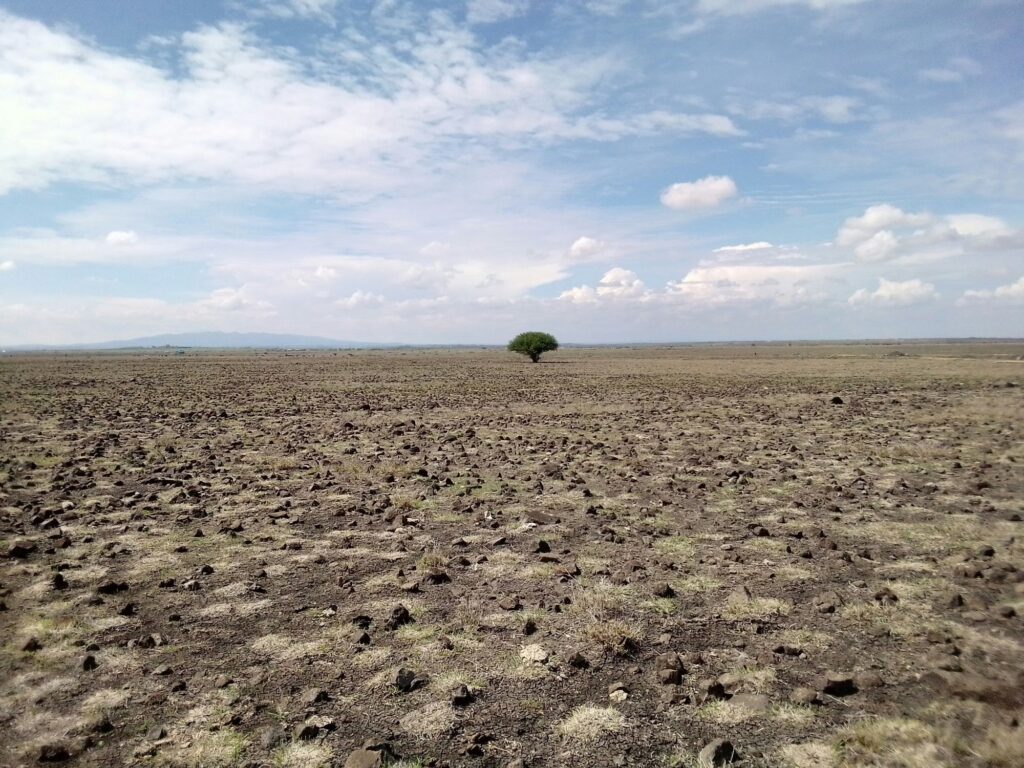
In 2022, I took a trip to Kajiado — a place I’ve always admired for its vast landscapes, resilient people, and the heart of the African Savanna. But that visit left me disturbed.
As I moved from one homestead to another, I noticed something strange: several farms were dotted with tall, dark eucalyptus trees — or mtimbao as they are commonly known.
At first, I couldn’t believe my eyes. Of all the tree species someone could plant in Kajiado — one of the driest counties in Kenya — why would anyone choose eucalyptus? For those who don’t know, Kajiado is a semi-arid region that receives very little rainfall each year. Droughts are frequent and brutal, and every few years herders lose livestock by the hundreds.
That year, 2022, was one of the worst droughts I had ever witnessed. I remember one of my neighbors losing all her 200 sheep. Another household, where I used to buy milk, had 150 head of cattle and managed to save only a few calves. The sun burned so hot that the soil cracked open, and pastures vanished. The few surviving plants were hardy shrubs, sisal, and the yellow-barked acacia trees that somehow withstand the harsh conditions.
Yet right there — in the heart of a place that struggles every year for water — people were planting eucalyptus trees.
When Good Intentions Go Wrong
It didn’t take long for me to understand what was happening. Most of the people planting eucalyptus weren’t local Maasai herders but new landowners — mostly city dwellers who had bought land in Kajiado. Since they had no immediate plans to build or settle, they decided to “invest” in trees.
Now, planting trees is a commendable act. We all want to contribute to environmental restoration and fight climate change. But what’s unfortunate is that many of these landowners plant trees without any research or consultation with forestry experts. They are driven by the simple belief that “trees are good for the environment.” And while that is generally true, not all trees are suitable everywhere.
During that trip, I visited several homes — including that of the former chief of Kitengela, who oversaw the transition from community to individual land ownership. His compound was full of acacia, grevillea, and pine trees — species well suited for the area. That made me wonder: why were others ignoring these more sustainable options?

The Eucalyptus Craze in Kenya
Eucalyptus has gained massive popularity across Kenya in recent years, and it’s easy to see why.
- Fast growth: Eucalyptus matures in as little as 6–10 years, while indigenous trees may take decades
- High demand: Its timber is strong, durable, and in high demand for poles, furniture, and building materials.
- Profitable: Farmers and investors see quick financial returns compared to other tree species.
- Adaptable: It can grow in different soil types, and some even plant it to “dry out” swampy land.
From a business perspective, eucalyptus looks like a miracle tree. But ecologically, it’s a nightmare, especially in water-scarce regions.
The Hidden Cost of Eucalyptus
Eucalyptus trees are sometimes referred to as “green deserts” because they grow fast but destroy everything else around them. Here’s why:
1. Water Depletion
Eucalyptus is extremely thirsty. Studies show that a single mature eucalyptus tree can draw up to 50 liters of water per day from the ground. When planted near rivers, streams, or wells, they lower the water table, drying up nearby sources.
In areas like Kajiado, Machakos, or Kitui — where rainfall is already minimal — planting eucalyptus can make the situation worse. Wells dry up, and nearby crops wilt. In some regions of Busia, farmers complain that their maize yields dropped after neighbors planted eucalyptus close to their farms.
2. Soil Degradation
Eucalyptus roots spread wide and deep, absorbing nutrients and leaving the soil exhausted. Its leaves release chemicals that suppress the growth of other plants, making it hard for grass, crops, or even weeds to grow underneath. This means less pasture for livestock and less biodiversity.
3. Loss of Biodiversity
Unlike indigenous trees, eucalyptus supports very few birds, insects, or small animals. Once a farm or forest is dominated by eucalyptus, it becomes a biological desert — silent and lifeless.
4. Fire Risk
Eucalyptus contains natural oils that make it highly flammable. During dry seasons, eucalyptus plantations burn fiercely and spread fire quickly, putting communities and wildlife at risk.
A National Problem — Not Just Kajiado
This issue isn’t limited to Kajiado. Across the country, eucalyptus has taken over landscapes at an alarming rate. Here in Busia County, for example, almost half the trees you see are eucalyptus. People plant them along rivers, near wetlands, or even in their compounds without considering the effects on neighbors or the ecosystem.
What’s worse, this overplanting is often encouraged unintentionally by government and community tree-planting drives.
Earlier this month, during Mazingira (Environment) Day, I watched people — including government officials — proudly planting eucalyptus seedlings. It was frustrating to witness. Instead of promoting climate-smart tree species, we are still celebrating a tree that depletes water and destroys soil fertility.
Understanding the Origin of Eucalyptus in Kenya
Eucalyptus isn’t native to Kenya — or even Africa. It was introduced during the colonial era in the early 1900s. The British brought it from Australia mainly for timber, firewood, and draining swamps around areas like Limuru and Kericho. Back then, the goal was purely commercial — not environmental.
It served its purpose in those high-rainfall areas. But over time, Kenyans adopted eucalyptus widely, even in unsuitable environments. What began as a practical solution has now turned into an ecological threat.
Climate Change and the Eucalyptus Question
Kenya is among the countries most affected by climate change. We are witnessing longer droughts, erratic rainfall, and increasing water scarcity. At such a time, we should be planting trees that conserve water, improve soil health, and support biodiversity — not those that worsen the situation.
Planting eucalyptus in arid and semi-arid areas is like trying to put out a fire using petrol. It defeats the purpose. Instead of mitigating climate change, we are amplifying its effects.
Why Regulation — or a Ban — Is Necessary
The government must take a firm stand on the eucalyptus issue. We’ve had discussions about it before — even the Ministry of Environment and the Kenya Forest Service (KFS) have, in the past, warned against planting eucalyptus near rivers and wetlands. But enforcement has been weak.
Kenya needs clear, enforceable policies that:
- Ban eucalyptus planting in dry and semi-arid counties (such as Kajiado, Machakos, Kitui, and parts of Busia and Baringo).
- Restrict planting near water sources — rivers, wetlands, boreholes, and irrigation canals.
- Promote alternative species by supporting nurseries that grow indigenous and environmentally friendly trees.
- Offer incentives to farmers who switch from eucalyptus to sustainable species like grevillea, croton, or pine.
Without strong regulation, we will continue to destroy our water catchments, worsen food insecurity, and undermine our fight against climate change.
Better Alternatives to Eucalyptus
Kenya has a wide range of tree species that are both profitable and environmentally sustainable. Some of the best options include:
Grevilalea robusta: Fast-growing, good for timber, and friendly to crops when used in agroforestry.
Croton: Indigenous, drought-resistant, and has potential for oil extraction and animal feed.
Acacia: Ideal for dry areas; provides shade, fuelwood, and fodder for animals.
Mukau (Melia volkensii): Native to Eastern Kenya; provides quality hardwood and thrives in dry regions.
Moringa: Not only a source of nutrition but also excellent for soil improvement and water conservation.
If the government and private nurseries focused on these species instead, we could restore degraded lands while still supporting tree-based livelihoods.
Also read: Trees: Africa’s Next Economic Frontier Through Carbon Credits
Lessons from Other Countries
Kenya isn’t the first country to face the eucalyptus dilemma. Several nations have already acted:
Ethiopia has restricted eucalyptus planting near water bodies.
Tanzania enforces strict zoning for eucalyptus plantations.
South Africa has actively removed eucalyptus in areas where it affected river flow and biodiversity.
If our neighbors can take bold steps, so can we.
The Role of Citizens and Farmers
As Kenyans, we must take responsibility too. Let’s not just plant trees blindly because everyone is doing it. Before you plant, ask yourself three questions:
- Is this tree suitable for my region’s rainfall and soil type?
- Will it harm my water sources or my neighbor’s farm?
- Is there a better alternative that supports both nature and my income?
If more people asked these questions, we would already be halfway to solving this problem.
A Call for a Smarter Mazingira Day
Every year, during Mazingira (Environmental) Day, Kenyans gather to plant millions of trees. It’s a beautiful tradition — but we must make it smarter.
The goal shouldn’t be to just increase the number of trees planted, but to increase the number of the right trees planted in the right places.
Imagine a future Mazingira Day where every seedling in the ground is an indigenous or water-friendly species. That’s the Kenya we should be building.
Conclusion: Time to Protect What Sustains Us
Eucalyptus has its uses — especially in swampy, high-rainfall areas — but its unregulated planting across the country is causing silent devastation. What began as a profitable venture is now threatening our water security, our soils, and ultimately our future.
From what I saw in Kajiado in 2022 — the drought, the dying livestock, the dry earth — I became convinced that we need to rethink our relationship with this tree. Planting eucalyptus in dry regions is like drilling a hole in your own water tank and then wondering why you’re thirsty.
3It’s time for Kenya to act. Let’s protect our land, our water, and our livelihoods — not just for ourselves but for generations to come.
My prayer is that one day, we will have a Mazingira Day where no eucalyptus is planted, only trees that heal our land, feed our people, and restore our environment.
Read more on Environment and Climate Action: EU’s New Coffee Guidelines: A Wake-Up Call for Kenyan Farmers

Disclosure: This banner contains an affiliate link. I may earn a commission if you purchase through it, at no extra cost to you.
